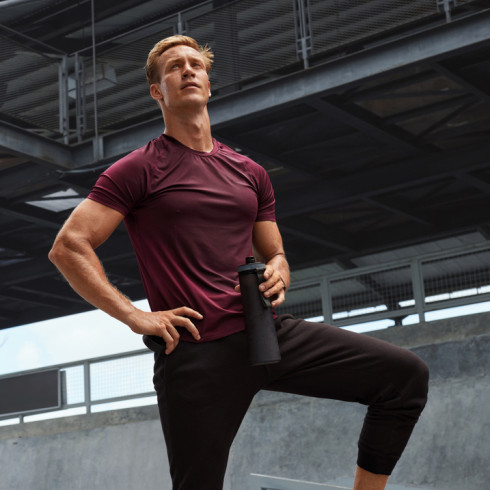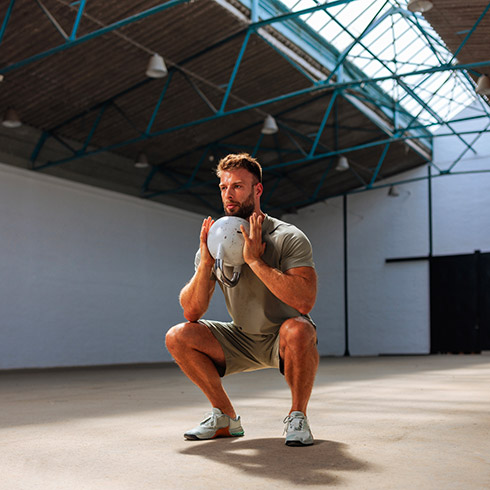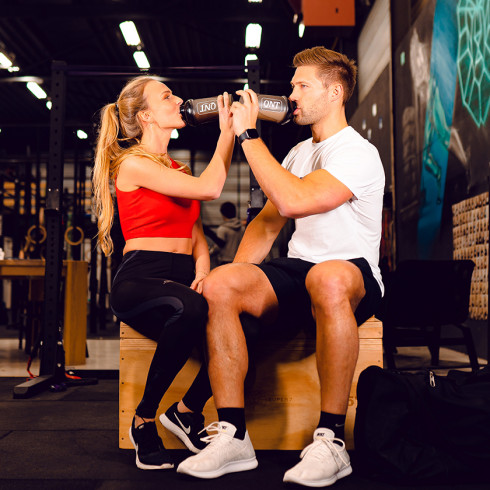All aspects of weight training revealed.
What Is Weight Training ?
Weight training is a sport discipline aimed at developing strength, endurance, and muscle volume through targeted exercises using additional weights or body weight. This practice can be tailored to various goals such as muscle mass gain, fat loss, improved athletic performance, or overall well-being.
Weight training encompasses several distinct disciplines, each with specific goals, techniques, and training methods. Here's an overview of the differences between bodybuilding, power training, powerlifting, and weightlifting :
Bodybuilding.
Main objective: Aesthetic and symmetrical development of muscles.
- Training: Combination of compound and isolation exercises with a focus on exercise variation, moderate to high repetitions (typically 8-12 reps).
- Nutrition: Strict and often highly specific diet to maximize muscle growth and minimize body fat.
- Competitions: Judged on physical appearance, muscle definition, symmetry, and proportion.
- Examples of competitions: Mr. Olympia, Arnold Classic.
Power Training.
Main objective: Improvement of muscular power, which is a combination of strength and speed.
- Training: Explosive exercises with moderate weights, often integrated into conditioning programs for athletes from other sports.
- Nutrition: Focused on supporting performance, with a balance of macronutrients for energy and recovery.
- Competitions: Nothing specific to power training, but often utilized within training frameworks for sports requiring power (such as football, basketball, volleyball, boxing, etc.).
Powerlifting.
Main objective: To lift the maximum weight possible in three main movements: squat, bench press, and deadlift.
- Training: Training focused on maximal strength with low repetitions (1-5 reps) and heavy loads.
- Nutrition: Focus on sufficient calorie intake to support intense training and recovery, often with less concern for precise body composition compared to bodybuilding.
- Competitions: Athletes are judged based on the total combined weight lifted in the three movements.
- Examples of competitions: World Powerlifting Championships, IPF (International Powerlifting Federation) competitions.
Weightlifting.
Main objective: To lift the maximum weight possible in two Olympic movements: snatch and clean and jerk.
- Training: Focus on technique, speed, and explosive strength, with low repetitions and heavy weights.
- Nutrition: Importance of adequate calorie and nutritional intake for performance and recovery, with specific attention to weight categories in which athletes compete.
- Competitions: Athletes are judged based on the total combined weight lifted in the two movements.
- Examples of competitions: Olympic Games, World Weightlifting Championships.
Summary table.
| Discipline | Main Objective | Training | Competitions | Nutrition |
| Bodybuilding | Aesthetic and muscular symmetry | Moderate sets, variations | Judged on physical appearance | Strict and precise for muscle growth and fat loss |
| Power Training | Power (strength + speed) | Explosive exercises | No specific competitions | Balanced for performance and recovery |
| Powerlifting | Maximum strength in three movements | Heavy loads, low reps | Combined total weight lifted | Caloric to support strength and recovery |
| Weightlifting | Lifting weights in two Olympic movements | Technique, speed, explosive strength | Combined total weight lifted | Caloric and tailored to weight categories |
These disciplines, although all focused on muscular training, distinguish themselves through specific objectives, training methods, and competition criteria.
Bodybuilding Goals.
- Muscle Mass Gain: The primary goal is to increase muscle volume (hypertrophy) through intensive training with heavy weights and a diet rich in protein and calories.
- Fat Loss: Used to burn fat by increasing basal metabolism. Bodybuilding, combined with appropriate nutrition, helps reduce fat mass while preserving muscle mass.
- Enhancement of Athletic Performance: Athletes from various sports use bodybuilding to improve their strength, power, and prevent injuries.
- Overall Well-being and Aging: Bodybuilding helps maintain muscle mass and bone density, which is crucial for healthy aging.
Principles of Bodybuilding.
- Progressive Overload: Gradually increasing weights to stimulate muscle growth.
- Variation of Exercises: Changing exercises to target different muscle groups and avoid stagnation.
- Recovery: Importance of rest periods to allow muscles to repair and grow.
- Nutrition: Balanced diet rich in proteins is essential to support bodybuilding efforts.
Training Methods.
- Compound Exercises: Squats, deadlifts, bench press, etc., which engage multiple muscle groups simultaneously.
- Isolation Exercises: Curls, triceps extensions, etc., to specifically target a single muscle or muscle group.
- Bodyweight Training: Utilization of body weight for exercises such as push-ups, pull-ups, and dips.
Benefits of Bodybuilding.
- Increase in Muscle Strength and Endurance.
- Improvement of Body Composition (muscle/fat ratio).
- Strengthening of Joints and Bones.
- Enhancement of Posture and Coordination.
- Reduction of Injury Risk.
In summary, bodybuilding is a versatile practice that caters to everyone, regardless of age or fitness level, and can be adapted to achieve various health and performance goals.
Training Methods in Weight Training According to Objectives.
In bodybuilding, training methods vary widely depending on the specific goals of the practitioners. Here is a description of different methods tailored to common bodybuilding objectives.
1. Muscle Mass Gain (Hypertrophy).
Objective: Increase muscle volume and size.
Training Methods:
- Volume Training: Using sets of 8 to 12 repetitions with moderate to heavy weights. The number of sets per exercise is generally high (3 to 6 sets), and the number of exercises per muscle ranges from 3 to 5 depending on the muscle.
- Split Training: Dividing muscle groups across different days to focus intensively on one or two groups per session (e.g., day 1 – chest and triceps, day 2 – back and biceps).
- Supersets and Dropsets: Advanced techniques to increase intensity by chaining multiple exercises without rest or gradually decreasing weights while continuing repetitions.
- Linear Periodization: Planning training phases with a progressive increase in weights and volume over several weeks.
Examples of Programs:
- Push-Pull-Legs (PPL) Muscle Building Program
- Classic Split Program (Chest, Back, Legs, Shoulders, Arms)
2. Fat Loss (Definition).
Objective: Reduce body fat while preserving muscle mass.
Training Methods:
- Circuit Training: Sequentially performing multiple exercises with minimal rest between sets to increase calorie expenditure.
- Combination of Cardio and Strength Training: Integrating high-intensity cardio sessions (HIIT) after strength training sessions or on separate days to maximize fat burning.
- High-Intensity Interval Training (HIIT): Short bursts of intense exercise alternated with periods of rest or moderate effort to sustain high energy expenditure.
- Maintaining Muscle Tension: Using high-repetition sets (12-20 reps) with light to moderate weights to promote muscle definition without sacrificing muscle mass.
Be mindful not to neglect muscle stimulation to prevent excessive muscle loss during cutting phases.
Examples of Programs:
- HIIT combined with strength training
- Full-body circuit training program
3. Improvement of Sports Performance.
Objective: Increase sport-specific strength, power, and endurance.
Training Methods:
- Plyometric Training: Explosive exercises to develop power and speed (jumps, medicine ball throws).
- Functional Strength: Compound and multi-joint exercises (squats, deadlifts, presses) to improve overall strength and muscle balance.
- Variable Resistance Training: Using bands or chains to vary resistance throughout the movement, enhancing strength and power across the range of motion.
- Undulating Periodization: Alternating phases of intensity and volume to maximize strength and endurance gains while avoiding stagnation.
Examples of Programs:
- Powerlifting Strength Program
- Sport-Specific Physical Preparation Program (football, basketball, etc.)
4. Powerlifting.
Objective: Maximize maximal strength in three primary movements: squat, bench press, and deadlift.
Training Methods:
- Strength-specific Training: Sets of 1 to 5 repetitions with very heavy loads (85-95% of 1RM).
- Linear or Undulating Progression: Gradual increase in weights with deloading phases to allow for recovery and prevent overtraining.
- Use of Assistance Methods: Accessory exercises to strengthen secondary muscles and enhance performance in main lifts (good mornings, dumbbell bench press, etc.).
- Technique and Form: Emphasis on perfecting technique and form to maximize efficiency and reduce the risk of injuries.
Examples of Programs:
- Texas Method Program
- Jim Wendler's 5/3/1 Program
5. Weightlifting.
Objective: Optimize performance in two Olympic lifts: snatch and clean and jerk.
Training Methods:
- Olympic Movements Specific Training: Frequent repetition of Olympic movements with a focus on technique and speed.
- Maximal Strength Training: Auxiliary exercises to increase maximal strength, including front and back squats, Olympic pulls, and presses.
- Intensity Training: Short sets with heavy loads (1-3 repetitions) to develop power and explosiveness.
- Classic Periodization: Targeted training periods with accumulation, transmutation, and realization phases to prepare for competitions.
Examples of Programs:
- Bulgarian School Program
- Soviet School Program
Each bodybuilding goal requires a specific approach in terms of training methods, nutrition, and planning. By adapting one's training to their personal goals, it's possible to maximize results and progress effectively and safely.
What Weight Should I Use in Weight Training ?
To determine the Ideal Load :
The load you should use in bodybuilding depends on several key factors: the ability to maintain proper form, control of the movement, full range of motion, and avoidance of momentum. Here's a detailed explanation for each aspect:
1. Maintaining Proper Form:
- Importance of Technique: The priority is always to maintain correct technique to prevent injuries and ensure exercise effectiveness. Poor form can lead to unnecessary strain on joints and muscles, increasing the risk of injury.
- Movement Control: The weight chosen should allow for controlled movement without cheating. For example, avoiding using momentum to complete a repetition is crucial. Each repetition should be performed with strict and precise form.
2. Full Range of Motion:
- Importance of Range of Motion: Using a load that allows for full range of motion is essential. This means being able to complete the entire movement without restricting the distance traveled by the muscle.
- Avoiding Compensations: If you reduce the range of motion to lift heavier, you risk not properly engaging the target muscles.
3. Avoiding Momentum:
- Momentum and Cheating: Using momentum (for example, swinging to lift a weight) decreases training effectiveness and increases the risk of injury. The load should allow for maintaining control of the movement from start to finish, without relying on momentum.
4. Choosing the Load Based on Goals:
- Hypertrophy: For muscle mass gain, using weights that allow 8 to 12 repetitions with good form is generally recommended.
- Strength: To increase strength, it is advised to use heavy weights allowing 1 to 5 repetitions, focusing on perfect form.
- Muscular Endurance: To improve muscular endurance, lighter weights allowing for 15 repetitions or more are recommended.
5. Progression:
- Monitoring and Adjustment: It's important to track progress and adjust loads based on improvements. When you can perform more repetitions than expected with good form, it's time to gradually increase the weight.
- Listening to Your Body: Learning to listen to your body is essential. Loads should be increased progressively and sensibly to avoid overtraining and injuries.
Practical Application.
Example of Determining Load for Bench Press :
- Warm-up: Start with an empty bar to warm up and practice technique.
- Progressive Loads: Gradually add weight, performing 5 to 10 repetitions at each increment to assess difficulty.
- Working Load: Identify a weight with which you can perform 8 to 12 repetitions with impeccable form, without relying on momentum or shortening the range of motion.
- Monitoring: Keep track of the weight and repetitions for each session and adjust weights as you progress.
The ideal load in bodybuilding is one that allows for maintaining proper form, complete control of movement, and full range of motion without using momentum. Listening to your body and progressively adjusting loads based on your progress are essential to optimize your results and prevent injuries.
How Many Days a Week Should I Train ?
Factors to Consider in Determining Training Frequency :
Optimal training frequency in bodybuilding varies depending on several individual factors, including personal availability, recovery capacity, session intensity, and specific goals. Here is a detailed explanation of these factors and general recommendations for planning your sessions.
1. Individual Availability:
- Personal Schedule: Your personal schedule plays a crucial role. Some individuals may dedicate more time to training than others based on their professional, family, and social obligations.
- Flexibility and Adaptability: It's important to create a realistic and sustainable program. If you can only train 3 days a week, focus on more comprehensive and intensive sessions.
2. Recovery Capacity:
- Listening to Your Body: Recovery varies from person to person. If you experience excessive fatigue, persistent soreness, or lack of motivation, it may be necessary to reduce the frequency or intensity of your sessions.
- Active Recovery: Incorporating active recovery days with light activities such as yoga, walking, or stretching can promote better recovery without completely interrupting physical activity.
3. Session Intensity:
- High-Intensity Training: If your sessions are very intense, it may be necessary to reduce frequency to allow for adequate recovery. For example, sessions focused on maximal strength require more rest time.
- Moderate-Intensity Training: With moderate-intensity sessions, you can train more frequently without risking overtraining.
4. Specific Goals:
- Hypertrophy: For muscle mass gain, training 3 to 6 days per week is common, with a split of muscle groups to allow for adequate recovery.
- Strength: Strength programs like powerlifting may require 3 to 4 days of training per week, focusing on main lifts with sufficient recovery between sessions.
- Muscular Endurance: For endurance, a higher frequency of 4 to 6 days can be beneficial, including sessions of lower intensity to allow for active recovery.
General Recommendations for Training Frequency.
1. Beginners
- Frequency: 3 days per week
- Typical Program: Full-body workout in each session
- Recovery: One rest day between each session to allow for recovery
2. Intermediate
- Frequency: 4-5 days per week
- Typical Program: Split program (dividing muscle groups across different days) or push-pull-legs.
- Recovery: Alternating muscle groups to allow for targeted recovery.
3. Advanced
- Frequency: 5-6 days per week
- Typical Program: Advanced split program focusing on weaknesses and isolation exercises.
- Recovery: Incorporation of active recovery days or light sessions.
How Long Should a Workout Session Last ?
Optimal Duration of Weightlifting Sessions :
The optimal duration of a weightlifting session can vary depending on several factors, including training goals, experience level, session intensity, and required recovery time. For optimal efficiency and to avoid joint strain, a session targeting a muscle group should not exceed 40 minutes.
Key Factors to Consider.
1. Intensity and Effectiveness:
- Focus on Intensity: An effective session relies on intensity rather than duration. This means each set and repetition should be performed with maximum focus and an appropriate load to stimulate muscle growth.
- Time Limit: Sessions that are too long can lead to decreased intensity, increased fatigue, and lower exercise execution quality, reducing the benefits of training.
2. Joint Injury Prevention:
- Overuse and Injuries: Prolonged sessions increase the risk of muscle and joint overuse, leading to potential injuries. Limiting session duration helps maintain proper form and prevent joint injuries.
- Progressive Overload: By focusing on shorter yet more intense sessions, progressive overload can be achieved gradually without overloading the joints.
3. Managing Fatigue and Recovery:
- Muscular Fatigue: Long sessions can lead to excessive muscular fatigue, which may affect performance in subsequent exercises and compromise recovery.
- Optimal Recovery: Shorter sessions help manage fatigue better and optimize recovery between sessions, promoting better long-term progression.
1. Beginners:
- Duration: 30 to 45 minutes per session.
- Structure: Focus on basic exercises with moderate repetitions and appropriate rest periods (60-90 seconds between sets).
- Example Session:
- Squat: 3 sets of 10 repetitions
- Bench press: 3 sets of 10 repetitions
- Rowing: 3 sets of 10 repetitions
- Crunches: 3 sets of 15 repetitions
2. Intermediates:
- Duration: 45 to 60 minutes per session.
- Structure: Introduction of variations and supplementary exercises for each muscle group with moderate rest periods (45-60 seconds between sets).
- Example Session:
- Deadlift: 4 sets of 8 repetitions
- Pull-ups: 3 sets of 10 repetitions
- Overhead press: 4 sets of 10 repetitions
- Leg press: 3 sets of 12 repetitions
3. Advanced:
- Duration: 60 to 75 minutes per session.
- Structure: Incorporate advanced techniques such as supersets, dropsets, and pyramid sets to increase intensity and variety.
- Example Session:
- Squat: 5 sets of 6 repetitions
- Bench press: 5 sets of 6 repetitions
- Bent-over rows: 4 sets of 8 repetitions
- Dips: 4 sets of 10 repetitions
When Will I See Results ?
Factors Influencing Progression in Bodybuilding :
Progression in bodybuilding depends on several crucial factors, such as the consistency of training, the intensity of sessions, and nutrition. Initial results may appear after a few weeks, but achieving significant changes typically requires several months of diligent work. Here's a detailed explanation of these factors and realistic expectations regarding results.
Key Factors Affecting Results.
1. Consistency of Training:
- Importance of Consistency: To see results, it is essential to train regularly. Bodybuilding relies on the principle of progressive overload, where muscles are continually challenged to adapt and grow.
- Planning and Discipline: Following a structured training program and maintaining discipline are crucial. Missed or irregular sessions can slow down progress and affect results.
2. Intensity of Sessions:
- Effort and Load: The intensity of sessions plays a major role. Working with appropriate weights and ensuring each set is performed to muscle fatigue (but not total exhaustion) is important to stimulate muscle growth.
- Varying Techniques: Using different training techniques such as supersets, dropsets, and exercise variations can help maintain high intensity and avoid stagnation.
3. Nutrition:
- Adequate Nutrition: Nutrition is a cornerstone of muscle building progress. Consuming sufficient amounts of proteins, carbohydrates, and healthy fats to support muscle growth and recovery is essential.
- Supplements: Dietary supplements such as protein powders, amino acids, and creatine can help optimize results, but should not replace a balanced diet.
Time to See Results.
1. First Weeks:
- Neuromuscular Adaptation: The initial improvements observed are often due to neuromuscular adaptations. You may experience better coordination and increased strength even without visible changes in muscle size.
- Motivation and Perception: Noticing rapid progress in strength and endurance can be very motivating, even if aesthetic changes are not yet visible.
2. 1 to 3 Months:
- Muscle Hypertrophy: After about 6 to 8 weeks, signs of muscle hypertrophy (increase in muscle size) begin to appear, especially if you follow a well-structured training program and diet.
- Body Changes: Clothes may start fitting better, and you may notice a reduction in body fat and improved muscle definition.
3. 6 Months and Beyond:
- Significant Changes: After 6 months of consistent work, significant changes in body composition and muscle mass will be evident. You may also notice notable improvements in strength, endurance, and overall performance.
- Evaluation and Adjustment: At this stage, it's beneficial to reassess your program and make adjustments based on your progress and new goals.
Realistic Expectations and Motivation
- Patience and Perseverance: Bodybuilding is a long-term process. Significant results take time, and perseverance is essential to achieve your goals.
- Setting Short-Term Goals: Setting short-term goals can help stay motivated and track ongoing progress.
- Monitoring and Adaptation: Keeping a training journal and tracking your diet can help identify what works and what needs adjustments to optimize results.
Progression in bodybuilding is influenced by the regularity of training, the intensity of sessions, and proper nutrition. Initial results may appear after a few weeks, but significant changes typically require several months of consistent effort. To maximize results, it's crucial to remain patient, disciplined, and adjust your program based on your progress.
Coach's Tips.

- The training program isn't always dependent on diet. During a cutting phase, it's possible to lift heavier weights (10-12 reps). This stimulates muscle volume. Definition primarily comes from diet rather than training. However, with calorie depletion, the body becomes weaker and one must be cautious of injuries such as tendonitis and joint issues.
- Cheating during a workout isn't ideal, as explained earlier. However, some programs allow cheating to get muscles accustomed to heavier loads. In such cases, the initial repetitions should be strict, and when unable to continue, substantial help through cheating or slightly tossing the weight is permissible. Beware that tossed movements are more likely to cause injuries because the weight isn't controlled!
- Large muscles require more recovery than small muscles. Working out each muscle each time it recovers, legs can be exercised every 6 days, chest, back, and shoulders every 5 days, and arms every 3 days. You can try this, it is impossible to progress well like this, because at one time the workouts will overlap, and you will have days when there is nothing to do and days when you should do your legs, shoulders, and arms, which might be good for the muscle, but your body will fatigue more quickly, and instead of gaining volume, you risk overworking yourself.
- Regarding progression, you will not easily see your progress. On the other hand, others might tell you that you have changed, which is a good sign! Alternatively, record your performance to observe progress in weights during training. Alternatively, have yourself regularly measured to objectively see the progress achieved.
Related posts
-
 Summer holidays: How to limit the damage?
Posted in: Our tips24/06/2021On holiday, we often tend to let ourselves go. Unless you're a hardcore sportsman, you tend to abandon your trainers...Read more
Summer holidays: How to limit the damage?
Posted in: Our tips24/06/2021On holiday, we often tend to let ourselves go. Unless you're a hardcore sportsman, you tend to abandon your trainers...Read more -
 Which fat burner to choose?
Posted in: Our tips26/05/2021To lose weight and burn fat, there is no secret: you have to do sport and take care of your diet. However, it is...Read more
Which fat burner to choose?
Posted in: Our tips26/05/2021To lose weight and burn fat, there is no secret: you have to do sport and take care of your diet. However, it is...Read more -
 Summer body edition for men: How to prepare your body?
Posted in: Our tips11/05/2021Gentlemen ? The return of the sun and its warm rays are almost here! The degrees are slowly but surely rising, but...Read more
Summer body edition for men: How to prepare your body?
Posted in: Our tips11/05/2021Gentlemen ? The return of the sun and its warm rays are almost here! The degrees are slowly but surely rising, but...Read more -
 9 good reasons to do sport.
Posted in: Our tips22/04/2021Sometimes the urge to exercise is not always there. And although we always tell ourselves that this year will finally...Read more
9 good reasons to do sport.
Posted in: Our tips22/04/2021Sometimes the urge to exercise is not always there. And although we always tell ourselves that this year will finally...Read more -
 Discover how to take care of your faithful companion: your shaker!
Posted in: Our tips07/04/2021In your bag, in your hand, in your sink, it is everywhere! The shaker is an essential element of any good training....Read more
Discover how to take care of your faithful companion: your shaker!
Posted in: Our tips07/04/2021In your bag, in your hand, in your sink, it is everywhere! The shaker is an essential element of any good training....Read more
Blog categories
Popular posts
-
 Looking thinner but at a heavier weight? Is that possible?04/10/2021Posted in: Our tipsAdvertising has shaped our thinking! We have been forced for years to believe that losing weight is the key to having...Read more
Looking thinner but at a heavier weight? Is that possible?04/10/2021Posted in: Our tipsAdvertising has shaped our thinking! We have been forced for years to believe that losing weight is the key to having...Read more -
 Proteins for weight loss !29/12/2023Posted in: Our tipsDive into the fascinating world of proteins and their key role in weight loss. Discover how to choose the best...Read more
Proteins for weight loss !29/12/2023Posted in: Our tipsDive into the fascinating world of proteins and their key role in weight loss. Discover how to choose the best...Read more -
 Which foods boost testosterone levels ?07/05/2021Posted in: Food supplementsTestosterone, often associated with virility, has much more to offer than you might think. It plays a crucial role in...Read more
Which foods boost testosterone levels ?07/05/2021Posted in: Food supplementsTestosterone, often associated with virility, has much more to offer than you might think. It plays a crucial role in...Read more -
 10 BENEFITS OF GLUTAMINE.02/01/2024Posted in: Our tipsDiscover the power of L-glutamine, an underrated superhero in the world of amino acids! Essential for revitalizing...Read more
10 BENEFITS OF GLUTAMINE.02/01/2024Posted in: Our tipsDiscover the power of L-glutamine, an underrated superhero in the world of amino acids! Essential for revitalizing...Read more -
 Is there a link between sex and sport?14/11/2019Posted in: LifestyleMany have already asked questions about sex and sport. Most of the time, people want to be reassured by the many...Read more
Is there a link between sex and sport?14/11/2019Posted in: LifestyleMany have already asked questions about sex and sport. Most of the time, people want to be reassured by the many...Read more

.jpg)

